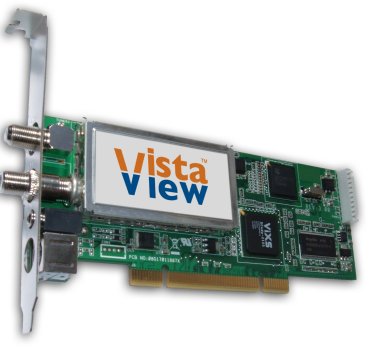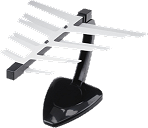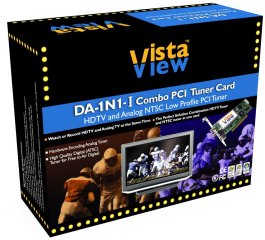Vista View Saber DA-1N1-I

As you may recall the FCC has mandated that in 2009 all analog TV will cease in the USA; any TVs, DVRs, etc. made from this point forward must also include an ATSC tuner. Vista View is the latest vendor to update their product line with a modern combination ATSC/NTSC tuner card. How will it stack up against the competition? Read on to find out.
Overview
Vista View went with chips from well known vendors.
The Saber DA-1N1’s foundation is from a vendor we’ve seen before in dual-tuner products from Vista View, NVIDIA and others: ViXS. ViXS has revamped their product line, they now offer single stream versions of the XCode family as well as versions with PCI Express x1 support (which Vista View uses in their upcoming PCIe version). The model used here is the XCode 2105. For digital TV we see the familiar LG "5th Generation" DT3303 ATSC demodulator. The DVICO Fusion 5 series and AVerMedia M780 also use the LG chip. Last but certainly not least is a new chip from Philips. The SAA7136/CE does the analog to digital duties — it features the common buzzwords we’ve come to expect from analog TV tuners in the last few years such as 10-bit A/D resolution, etc.
The Saber DA-1N1 works under Windows MCE 2005, Windows Vista, and I personally confirmed SageTV 6.1 works as well.
I had a pre-release sample, so I didn’t get the proper retail box, below is an image of the shipping box, it will include:
• Saber DA-1N1-I Combo Analog/Digital Low Profile PCI TV Tuner Card
• Audio cable – Mini Stereo to RCA
• S-Video to Composite adaptor
• Low Profile bracket
• Quick Installation Guide
• Saber DA-1N1-I drivers CD
|
|
|
The box the DA-1N1-I will ship with |
 |
|
The ports: digital TV, analog TV, audio line-in, s-video |
The card itself is low profile and so forgoes RCA (phono) style audio input as well as a dedicated composite video jack. Vista View does the right thing by including a stereo mini-jack to RCA cable for the audio line-in plus an s-video to composite video adapter. Some vendors leave one or both of these little cables out!
Analog Testing — S-video
Analog Testing
EDITORS NOTE: To see the details of how we test the analog tuner please read the staff blog on the subject titled Analog TV Tuners — How We Test.
s-video
|
|||||||||||||||||||||||||
Analog Testing — Composite video
Composite Video
|
|||||||||||||||||||||||||
Analog Testing — TV tuner
RF (tuner input)
NOTE: This test is perhaps the least accurate compared to a real antenna or cable feed, the test signal is fed via s-video into an RF modulator this process downgrades the image, this is most evident in the slight blurring/softness and a slight darkening of the image.
|
|||||||||||||||||||||||||
Digital TV Testing
Digital TV Testing
With digital TV either you have enough signal to receive a picture or you don’t. Digital results in a clear picture (depending on the source of course), no analog noise is introduced. However you don’t have much of any room for fudging signal strength. Dipping below 75% signal strength means there just isn’t enough of the data stream received without interruption for the ATSC error correction to keep up and you get a "no signal" error.
Both cards did very well, with a roof antenna and having towers all fairly close there aren’t really any complications that would trip up these TV cards.
 For a more torturous test I connected up my trusty Zenith SilverSensor and saw how well the Saber could pull in channels under far from ideal circumstances.
For a more torturous test I connected up my trusty Zenith SilverSensor and saw how well the Saber could pull in channels under far from ideal circumstances.
NOTE: This is far from a scientific test, this is a rather informal test and obviously conditions vary highly from region to region, so don’t take these results as the be all end all of signal strength.
The Saber got between 68% and 100% signal strength on various channels. This puts the Vista View card in the same ball park as the AVerMedia M780 which I had excellent performance with. This should come as no suprise as they use the same LG demodulator. For comparison the Hauppauge HVR-1600, which uses a Conexant ATSC demodulator, managed 58% to 81% signal strength in similar testing.
Conclusion
Final Thoughts
The Saber DA-1N1-I seems to be a success for Vista View. As expected the analog image quality was on par with the competition, and sticking to LG’s 3303 mean the DA-1N1 has very good digital TV reception. People looking for a small form factor PCI card should seriously consider the Saber DA-1N1-I.
Looking for a PCI Express version? Vista View has the same basic design using PCI Express in a full height card coming very soon. Since the card is effectively identical the performance and image quality should be exactly the same.


![picday_s [320x200].jpg picday_s [320x200].jpg](https://wp.missingremote.com/wp-content/uploads/2007/07/picday_s-320x200.jpg)
![hvr1600_picday_s [320x200].jpg hvr1600_picday_s [320x200].jpg](https://wp.missingremote.com/wp-content/uploads/2007/08/hvr1600_picday_s-320x200.jpg)
![colorbars_s [320x200].jpg colorbars_s [320x200].jpg](https://wp.missingremote.com/wp-content/uploads/2007/07/colorbars_s-320x200.jpg)
![hvr1600_colorbars_s [320x200].jpg hvr1600_colorbars_s [320x200].jpg](https://wp.missingremote.com/wp-content/uploads/2007/08/hvr1600_colorbars_s-320x200.jpg)
![graybars_s [320x200].jpg graybars_s [320x200].jpg](https://wp.missingremote.com/wp-content/uploads/2007/07/graybars_s-320x200.jpg)
![hvr1600_graybars_s [320x200].jpg hvr1600_graybars_s [320x200].jpg](https://wp.missingremote.com/wp-content/uploads/2007/08/hvr1600_graybars_s-320x200.jpg)
![res_s [320x200].jpg res_s [320x200].jpg](https://wp.missingremote.com/wp-content/uploads/2007/07/res_s-320x200.jpg)
![picday_c [320x200].jpg picday_c [320x200].jpg](https://wp.missingremote.com/wp-content/uploads/2007/07/picday_c-320x200.jpg)
![hvr1600_picday_c [320x200].jpg hvr1600_picday_c [320x200].jpg](https://wp.missingremote.com/wp-content/uploads/2007/08/hvr1600_picday_c-320x200.jpg)
![colorbars_c [320x200].jpg colorbars_c [320x200].jpg](https://wp.missingremote.com/wp-content/uploads/2007/07/colorbars_c-320x200.jpg)
![hvr1600_colorbars_c [320x200].jpg hvr1600_colorbars_c [320x200].jpg](https://wp.missingremote.com/wp-content/uploads/2007/08/hvr1600_colorbars_c-320x200.jpg)
![graybars_c [320x200].jpg graybars_c [320x200].jpg](https://wp.missingremote.com/wp-content/uploads/2007/07/graybars_c-320x200.jpg)
![hvr1600_graybars_c [320x200].jpg hvr1600_graybars_c [320x200].jpg](https://wp.missingremote.com/wp-content/uploads/2007/08/hvr1600_graybars_c-320x200.jpg)
![res_c [320x200].jpg res_c [320x200].jpg](https://wp.missingremote.com/wp-content/uploads/2007/07/res_c-320x200.jpg)
![hvr1600_res_c [320x200].jpg hvr1600_res_c [320x200].jpg](https://wp.missingremote.com/wp-content/uploads/2007/08/hvr1600_res_c-320x200.jpg)
![picday_rf [320x200].jpg picday_rf [320x200].jpg](https://wp.missingremote.com/wp-content/uploads/2007/07/picday_rf-320x200.jpg)
![hvr1600_picday_rf [320x200].jpg hvr1600_picday_rf [320x200].jpg](https://wp.missingremote.com/wp-content/uploads/2007/07/hvr1600_picday_rf-320x200.jpg)
![colorbars_rf [320x200].jpg colorbars_rf [320x200].jpg](https://wp.missingremote.com/wp-content/uploads/2007/07/colorbars_rf-320x200.jpg)
![hvr1600_colorbars_rf [320x200].jpg hvr1600_colorbars_rf [320x200].jpg](https://wp.missingremote.com/wp-content/uploads/2007/07/hvr1600_colorbars_rf-320x200.jpg)
![graybars_rf [320x200].jpg graybars_rf [320x200].jpg](https://wp.missingremote.com/wp-content/uploads/2007/07/graybars_rf-320x200.jpg)
![hvr1600_graybars_rf [320x200].jpg hvr1600_graybars_rf [320x200].jpg](https://wp.missingremote.com/wp-content/uploads/2007/07/hvr1600_graybars_rf-320x200.jpg)
![res_rf [320x200].jpg res_rf [320x200].jpg](https://wp.missingremote.com/wp-content/uploads/2007/07/res_rf-320x200.jpg)
![hvr1600_res_rf [320x200].jpg hvr1600_res_rf [320x200].jpg](https://wp.missingremote.com/wp-content/uploads/2007/07/hvr1600_res_rf-320x200.jpg)